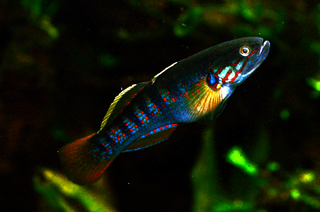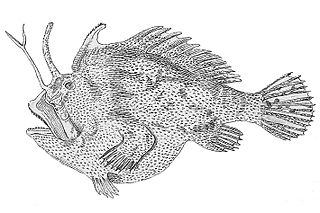
Eleotridae is a family of fish commonly known as sleeper gobies, with about 34 genera and 180 species. Most species are found in the tropical Indo-Pacific region, but there are also species in subtropical and temperate regions, warmer parts of the Americas and near the Atlantic coast in Africa. While many eleotrids pass through a planktonic stage in the sea and some spend their entire lives in the sea; as adults, the majority live in freshwater streams and brackish water. One of its genera, Caecieleotris, is troglobitic. They are especially important as predators in the freshwater stream ecosystems on oceanic islands such as New Zealand and Hawaii that otherwise lack the predatory fish families typical of nearby continents, such as catfish. Anatomically, they are similar to the gobies (Gobiidae), though unlike the majority of gobies, they do not have a pelvic sucker.
Devilfish or devil fish may refer to:
Collared wrigglers are perciform fishes in the family Xenisthmidae. They are native to the Indian and Pacific Oceans, where they are mostly reef-dwelling.

Acanthistius is a genus of ray-finned fish. Some authors place the genus in the family Anthiadidae, while others consider it to be incertae sedis, where it is not clear which family it belongs to.

Doryrhamphus and Dunckerocampus, popularly known as flagtail pipefish, are two genera of fishes in the family Syngnathidae. They are found in warm, relatively shallow waters of the Indo-Pacific, with a single species, D. paulus, in the eastern Pacific. Most of these pipefishes are very colourful, and are fairly popular in the marine aquarium hobby despite requiring special care and not being recommended for beginners.

Hypseleotris is a genus of fishes in the family Eleotridae. Most are from fresh water in Australia and New Guinea, but species in fresh and brackish water are found around islands in the western Indian Ocean, southern and eastern Africa, southern and eastern Asia, and Pacific islands. The largest species reaches a length of 12 cm (4.7 in). They are sometimes seen in the aquarium trade; especially H. compressa. In Australia they are known as carp gudgeons.

Schultz's pipefish, Corythoichthys schultzi, is a pipefish of the family Syngnathidae.

Chelmonops truncatus, the eastern talma or truncate coralfish, is a species of marine ray-finned fish, a butterflyfish from the family Chaetodontidae. It is endemic to Australia.
Heteroclinus kuiteri, or Kuiters weedfish, is a species of clinid native to the Indian Ocean coast of Australia.

Paraplesiops bleekeri, commonly known as the eastern blue devil, blue-tipped long-fin or Bleeker's blue devil fish, is a species of fish in the family Plesiopidae. This colourful, secretive fish is endemic to Australia, where it is a protected species.
Enneapterygius flavoccipitis, the yellownape triplefin or northern bicoloured triplefin, in Australia, is a species of threefin blenny in the genus Enneapterygius.

The southern blue devil is a species of fish in the longfin family Plesiopidae endemic to southern Australia. It is a close relative of the eastern blue devil, which lives in the coastal waters of eastern Australia, and of the western blue devil, of southwestern Western Australia with which it is sometimes considered conspecific.

The western blue devil is a species of fish in the longfin family Plesiopidae endemic to Western Australia. The fish is found in rocky reef habitats in the coastal, inshore waters of southwestern Western Australia, from the Recherche Archipelago to Lancelin. The specific name was coined as a memorial to the ichthyologist Nicholas Sinclair of the Australian Museum who was involved in the collection of the type specimens.
The northern blue devil is a species of fish in the longfin family Plesiopidae. It has been recorded from the inshore waters of Queensland, eastern Australia, from Bowen to Moreton Bay. The specific name honours Percy Power, who caught the type specimen.

Alison's blue devil is a species of fish in the longfin family Plesiopidae. It was described in 1984 and named for Alison Kuiter, the wife of Rudie Kuiter, because he said she saw the species first. It has a brown head and body with iridescent blue spots on the head. It has been recorded from various sites in southern Australian waters, including Port Phillip in Victoria, northern Tasmania and Tasmanian islands in Bass Strait, Kangaroo Island, and Victor Harbor in South Australia.

Echinophryne is a genus of marine ray-finned fishes belonging to the subfamily Histiophryninae in the family Antennariidae, the frogfishes. The fishes in this genus are endemic to the waters off Australia.

Kuiterichthys is a genus of marine ray-finned fishes belonging to the subfamily Histiophryninae in the family Antennariidae, the frogfishes. These fishes are endemic to Australia.

Priacanthus hamrur, the lunar-tailed bigeye, goggle eye, or moontail bullseye, is a species of marine fishes belonging to the family Priacanthidae.

Cochleoceps orientalis, common name eastern cleaner-clingfish, is a species of clingfish that is endemic to the marine waters around southeastern Australia.

The southern hulafish is a species of zooplanktivorous marine fish native to the temperate southern coast of Australia.















